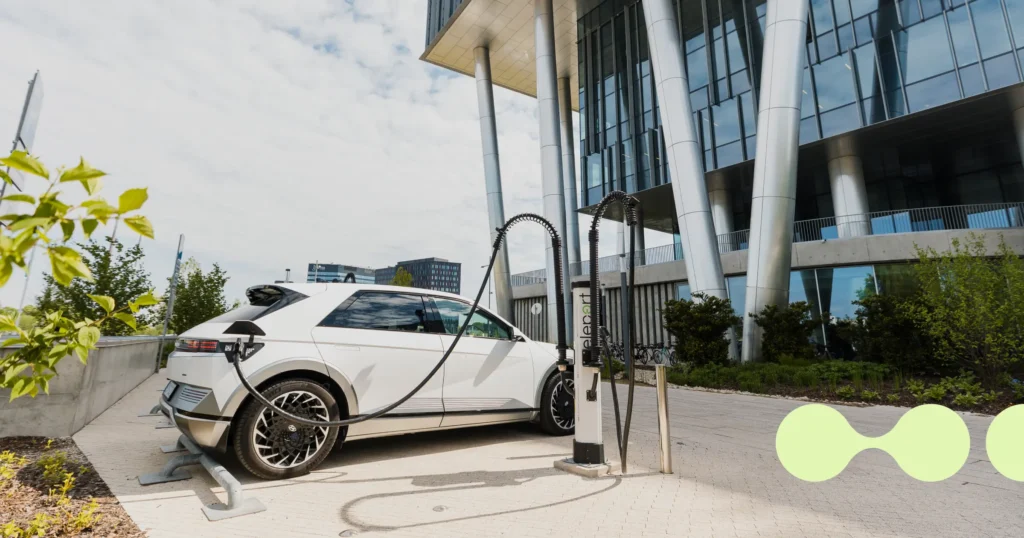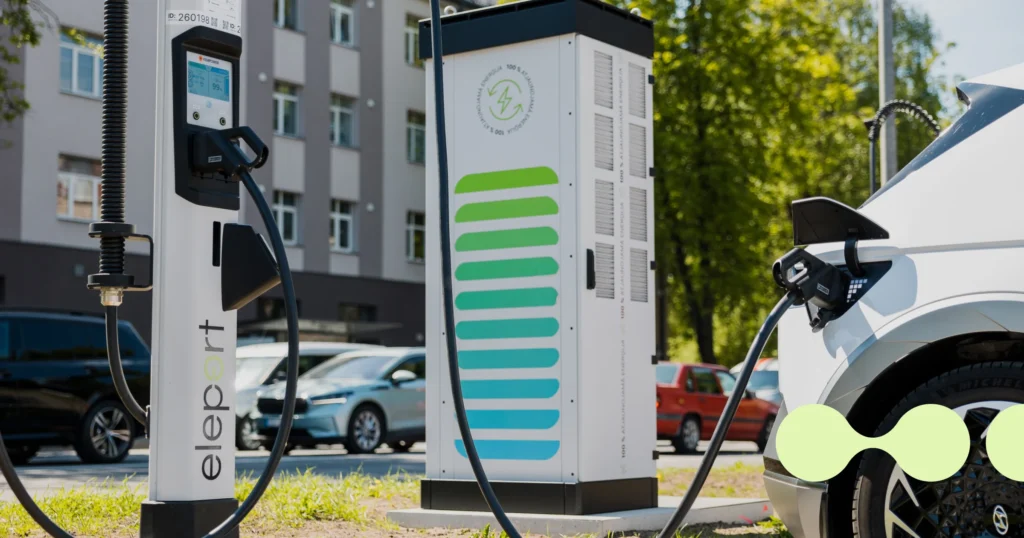As EV drivers, we get used to the intricacies of EV charging fairly quickly. What might have seemed foreign and complicated from afar before getting an EV, we actually get the hang of more easily than we first thought.
Just like we used to know when petrol or diesel prices per litre feel too expensive with just a glance, our gut can now estimate EV charging costs on whether a charging price per kWh makes sense to use or not.
But when it comes to public EV charging pricing, have you ever also asked yourself, what makes the price per kWh become exactly what it is?
…what is in a charging price, really?
Today, that is exactly what we’ll try to lay out. I have been researching the EV and charging industry for over five years now, and there is more work behind it all than you’d think.
And while we are used to getting the unified EV charging costs across most of the fast charging stations, much like Eleport provides per country, the story behind each specific site can vary significantly.
What Costs Does a Public Charging Site Come With?
We have already covered how does home charging affect EV costs in our recent article, so consider that we are talking solely of the real cost of charging electric car at a public station here.
In the grand view, ultimately, the kWh price reflects the classic cost-plus business model – we are being sold the service that includes all the costs and the company’s, in our case, the Charge Point Operator’s, profit margin.
1. Location, Location, Location
To understand the main EV charging costs, we’ll start right off with a big one – the charging location. Getting everything right here is one of the key pieces of the puzzle, which can easily make or break a charging site in several ways.
The land upon which the public chargers are deployed is mostly leased for a fixed period of time, along with a clear set of parameters around what is provided to, and demanded from, the Charge Point Operator (CPO). This will set up the parking space availability, size of the site, which can be smaller at first with an agreement for potential expansion, and all the rest of the variables.
The deals charging operators sign with land owners usually depend on how risk-adverse the landowner is and what the strategy of the CPO is like. It can be either dependent on revenue share per kWh charged or fixed fees. Nearly all of the deals mix the two, just in different ratios. This doesn’t necessarily change the charging costs for EV owners, but it matters for the business case.

The more potential the landowner sees in the charging station to become popular for charging a lot of EVs in the future, the higher the chance there is for the scales to be tilted towards revenue share in the agreement.
The CPO, on the other hand, can win from revenue share agreements early on when utilization of the chargers is low, but lose more in revenue thanks to the same deal once the site usage picks up.
2. Electricity Cost & Grid Connection
Of course, on top of the agreement, the electricity use for charging itself (and connected fees) must be paid by the CPO. Here, it can also go two ways – either the CPO handles the grid connection itself, or relies on the landowner’s utility agreement. In either case, the landowner doesn’t usually take any additional cut, and the electricity price is passed on to the charging operator as-is. Exceptions are still happening here and there, however.
In some parts of Europe, when the electricity price changes per demand hourly or in specific time periods, this is passed on to the charging costs for EV owners as dynamic pricing.
Permitting and grid connection are the two pieces of the puzzle that are usually counted as ones with the longest lead times. Ironically, getting the chargers on the ground often ends up being the quickest step, while permitting and grid updates can take years.
Depending on locations, getting the necessary connection to the grid can also lead to large upfront costs, or, as we can see in most deployments in Poland, can instead lead to small upfront but larger fees per kWh delivered. This is also what drives the higher charging costs for EV owners in public chargers in the country, compared to its neighbors.
The grid situation is also perhaps the largest difference between deploying chargers in different countries across Europe – each country has its unique set of challenges and costs involved.

3. Charging Hardware & Vandalism
Now, the investment in chargers is an obvious part of the whole system, and EV charging costs as well. While the pricing depends on the hardware chosen, we should also consider the costs that come with the charger after the procurement and installation. That would be the amortization of the asset, the maintenance needs, and sadly, also possible accidents and vandalism.
Bollards usually keep most of the accidents off, but we still end up seeing pictures of tipped-down chargers shared every now and then. Vandalism, or rather theft, on fast charger cables is becoming a larger problem both in Europe and the US. While the copper in the cables might net the thieves just a few hundred euros for a bulk of them, it will cost CPOs thousands to replace them.
The added security measures, whether it is site surveillance or cable guards, will yet again increase the EV charging costs for us all.
4. Battery Energy Storage
In addition to chargers, nowadays the charging sites are starting to include battery energy storage systems, which can both offer a buffer to be used to mitigate electricity price fluctuations, and also as a boost for charging power when there’s not enough grid capacity to charge with. Still, the battery storage deployment leads to larger upfront site development costs.
All the above are the EV charging costs that the charging operators need to cover, which can vary for each charging site that the charging network operates.
Let’s keep going with the costs of charging that go beyond each specific site, starting with what you can see even before you get to the charger.
5. Software
Having a great charging app matters. From the app you use to navigate to the site, the authentication of the charge, collection of the fee for your charging sessions, to the back-end systems that run the whole operation and management of the charging network – all this comes with a price tag.

Whether the platform is all built in-house or, as in a lot of cases, is actually outsourced to a special service provider, such as Eleport’s latest integration with Ampeco, building and using the platform always demands its own share of significant time and resources.
6. The Experience
As EV drivers, we easily notice the difference between a charging station that is just a few chargers slapped onto an easy space, and a real charging station that has created the site to be worthy of being a destination, commanding the whole experience. Convenience is everything.
This includes the real charging location design, which can include a canopy (preferably with solar), easily accessible stalls (extra points for a pull-through stall), and add-ons like vending machines or vacuums. Amenities right next to a charger matter as well, be it a restaurant or a dedicated bathroom facility. I know EV drivers who choose which charging networks they only use based on some of these available.
While all this comes with a price to build out and manage, a lot of these can be either efforts together with partners or built into the business model without adding too much to EV charging costs per kWh. But it can make all the difference for an EV driver.
Did we mention the people yet?
7. The People
Each step we’ve described wouldn’t be possible without the people behind it, and depending on the charging organization, the roles vary from those starting with the permits to the marketing team, from the software side to the hardware, all the way up to business development and running the whole organization. And of course, staff salaries and overheads are a major ongoing cost.

8. The Middlemen
The last thing that can add to the EV charging costs is optional on your own side. If you choose not to charge directly with a CPO but use a roaming service instead, that service comes with an added fee on top of the usual charging price, and can increase the costs to charge an EV.
These services are acting as e-mobility service providers (eMSPs) in between you and the charge point operator, and while necessary, will nearly always add something to every kWh you pull to your car.
9. Your Own EV’s Limits and Charging Habits
Yes, this can be something that influences your own charging costs for EV, or even the profit margin for the CPO. There are a few caveats in the public charging infrastructure that an EV driver needs to pay attention to.
One is that EVs have their charging limits. If you compare EV charging costs at a fast charger, say a 50 kW or 100 kW one, and an ultra-fast charger at over 250 kW or even 350 kW, the latter will always come with higher EV charge costs.
Many EVs, especially the ones produced years ago, are not actually able to take in such a high charging power or maintain the peak in their charging curve, which can lead to some waste on the EV owner’s side if using the higher-rated charger.
The other nuance comes with idle fees, as many CPOs start charging idle fees after a charging session is completed, but the EV isn’t unplugged. This can inflate the charging price of your session if not act according to the etiquette. With this, the operators defend themselves against losing out on utilization.
Utilization Is the Name of the Game
In general, although we are now seeing more specific sites achieve utilization that actually makes it look like a real working business case, the charging networks are mostly not built for the demand of today.
They are serving today’s drivers, too, of course, but the core focus is still in the future. The charging sites can already be mostly oversized today in a lot of countries, which can be seen most easily with lower utilization rates and sites that never have a line to charge. The smarter CPOs have designed most of their sites in a way that they can increase the charger count with agreements in place for future expansion. The scalable solutions should ideally also make the EV charging costs competitive at the sites, as opposed to oversized sites that have demanded a lot of upfront capital.
How many chargers are there in Europe today? Europe has just over a million public chargers today, with over 180,000 of them DC fast chargers as of 2024 (IEA 2025). Yet most of these DC charging locations are not in the break-even area yet.
Until The Future Arrives, Your Fast Charging Price Is Likely Subsidized (yes, really)
If there weren’t for some specific circumstances in our charging industry, your fast charging price would likely be much higher per kWh than it is today.
This is just the truth. Here’s why:
We are still in the scale-up phase of the charging industry. This means that a lot of the overhead costs, such as development of specific platforms or services & several other positions, are currently supported by external funds, which might not be the case once a charging network is more mature, or what you might call closer to “ready”.
It’s hard to determine right now which charging networks are actually break-even or even profitable today, but given that they are all building some for now and mostly for the future, it’s mostly at an unprofitable state.
Who will cover the cost of building it all out right now, yet waiting for the future utilization? Depending on the ownership structure, much of that extra cost is currently either swallowed by the parent company of the charging arm (think: automakers, utilities) or handled via equity investments (for independent CPOs) in the case of independent charging networks.
Lately, more than ever, another financing instrument has come into play for the larger networks – banks. As evident from the latest financing rounds of Ionity and Electra in Europe and EVgo in the US, the consortiums of banks are seeing the charging network locations now as proven assets, which can be loaned against for further expansion.
The EV charging costs you get at a public charging site are also often subsidized by the incentive schemes from either governments, or, in Europe’s case, on the European Union level. The Alternative Fuels Infrastructure Facility (AFIF), for example, is a EU grant program under the Connecting Europe Facility (CEF) that funds projects to build infrastructure for alternative fuels, like electric and hydrogen, across the EU’s trans-European transport network (TEN-T).
The 2024-2025 budget was one billion euros. This helps the charging operators cover some of the cost of site development, which would otherwise have to be reflected in the EV charging costs that would fall on the EV drivers.
The charging networks are balancing their prices to be competitive, and the funding is needed to make the pricing attractive enough for us as EV drivers today. In an ideal scenario, the additional funding will subsidize the charging prices in this indirect manner right until the EV adoption grows to the level where charging stations are utilized enough to be fully profitable.
Given that EV adoption is growing at a great pace in Europe – already every 6th EV sold in Europe is fully electric this year, per our research – this point will come sooner rather than later.
So is your current public charging price subsidized? Unless you happen to charge at a very well-used and efficiently built site, next time you plug in, remember that your €0.40/kWh session is still partly financed by automakers, investors, or EU grants. The true market pricing is likely higher until utilization catches up.



